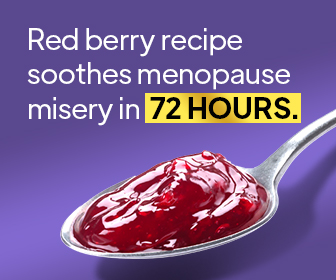Many of us will probably remember friends with dental braces back in school. Some of you may have even had braces yourselves. One thing we all remember is — braces weren’t “cool”. Having a mouth full of shiny metal wasn’t exactly attractive. But do adult braces have to have that effect? With so many types of braces out there today, we don’t think so.
Still, there are definitely some pros and cons to consider if you’re thinking about getting adult braces. Like any medical procedure, braces can be pricey. Additionally, there is some degree of discomfort and pain involved (we have some tips for you on how to manage this). Of course, the big reward after all of that will be getting the smile of your dreams!
Maybe you want braces to boost your self-confidence and get a Hollywood-style set of teeth. Or perhaps your dentist recommended braces to realign your over/underbite, or fight overcrowding in your mouth. Braces can even help with sleep and breathing disorders like sleep apnea and snoring.[1] Whatever the reason, let’s see if dental braces are really worth the financial cost and physical pain.
Adult Braces: Key Differences Getting Braces Now vs As a Kid
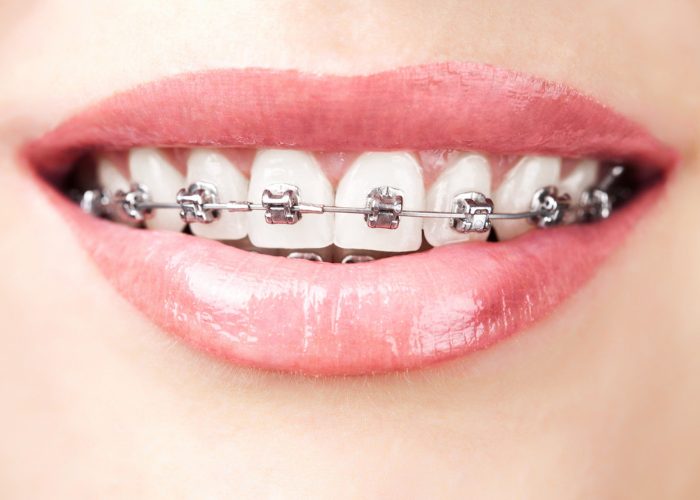
Getting teeth braces as an adult requires a few more considerations than if you were still a child. As you age, your body tends to become less mobile and more prone to infection. This goes for your teeth and oral health as well! Getting braces now is not as easy as stopping by the orthodontist and continuing on your merry way. You have to consider that your bones are set differently now that you’re an adult. Therefore, the treatment process will take longer and might come with added risks.
Still, this doesn’t mean adults shouldn’t get braces — on the contrary, adults should just be aware of the implications.
1. Teeth movement is slower in adults

Teeth are easier to move when you’re young.[2] This fact alone is a main reason people tend to get braces earlier in life. Easier tooth movement means faster results. But, because teeth are easier to move in children, they also are at a higher risk to shift after the braces come off.[3]
Adult teeth, on the other hand, will take a slightly longer time to move. This is because adult bones have stopped growing and shifting already. Therefore your teeth, especially the canine teeth, may take longer to move with adult braces.[4]
In some cases, braces might not even be possible. Because your adult bones have stopped growing, some structural changes cannot be accomplished without surgery.[5] Make sure to check with your dentist first and they’ll have x-rays done to see if braces are right for you and your goals.
2. It will take time and commitment
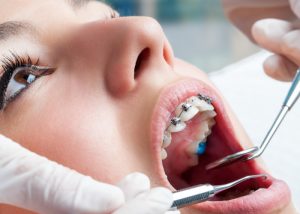
As a kid, your life is managed by your parents so you never have to worry about squeezing time in for the dentist. Typically, parents assume the management responsibility and ensure that dentist appointments are scheduled in between school and play.
As adults, we have to balance work, gym, social activities, self-care, and personal relationships. If you throw kids into the mix, there’s an even smaller chance to find a free moment in the day! Making your scheduled dentist appointments will take time and commitment.
That being said, it only takes a bit of planning and it won’t disrupt your schedule much. Some orthodontists see their patients every four weeks, and others as little as every 10 weeks.[6] Each tightening appointment should only last about 20 minutes.
In total, the length of your braces treatment could vary depending on the type and severity of movement needed. The standard time to plan for is one to two years.[7]
3. Adults have health factors to consider

For adults, there are some health factors to consider before committing to braces too. Moving teeth requires both bone formation and reabsorption.[8] For those who have osteoporosis or are at risk for it, braces may actually have a negative effect.[9] Additionally, post-menopausal women are at higher risk for these factors, and should be assessed before getting braces.[10]
4. Bracket failure is lower in adults
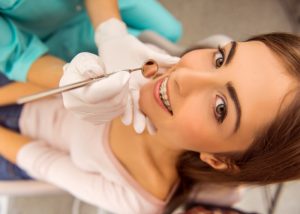
On a positive note, bracket failure is lower in adults.[11] In standard braces, brackets are the metal bindings that connect each tooth and the wire that runs along the teeth. In adults, the bond between the tooth and the glued on bracket is less likely to break, and thus negatively influence treatment time and pain levels. Reasons for this aren’t completely known, but it’s thought this is because adults take better care of their braces and have higher cooperation with orthodontists.[12] Score for maturity!
How Do Braces Work?
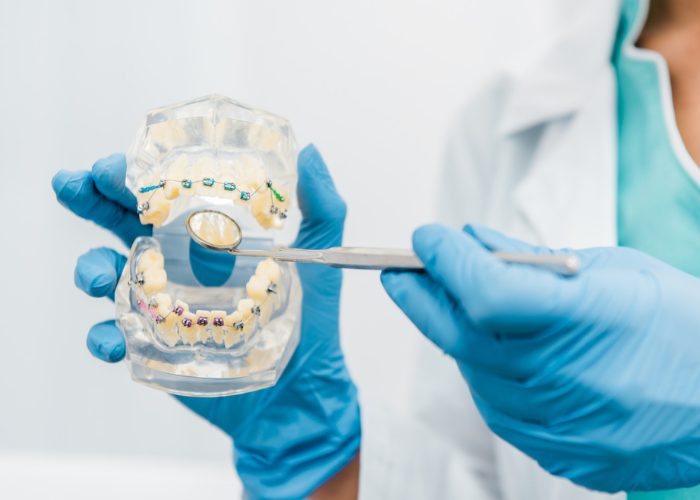
Before we get into how braces work, it’s important to understand teeth. Teeth are made of four layers: enamel, cement, dentine, and pulp.[13] They are visually divided into two parts: the crown and the root.[14] The crown is the part of the tooth you see in the mirror and that typically gets fused to braces. The root reaches beneath the gums and is surrounded by bone sockets to keep the tooth in place.[15]
Braces work by attaching to our tooth crown and pushing it to move in the desired direction.[16] As the crown moves, so does the root. But this is where the process might make you squeamish. As the root moves, it breaks down the bone socket holding it in place, bit by bit.[17] This creates new space for the tooth to move into. The leftover space on the other side of the root is quickly filled up again with more bone.[18]
Tip: Keep your teeth and braces super clean throughout treatment to avoid any discoloration effects. Brush as normal, and don’t forget to floss daily too!
How Much Do Braces Cost?
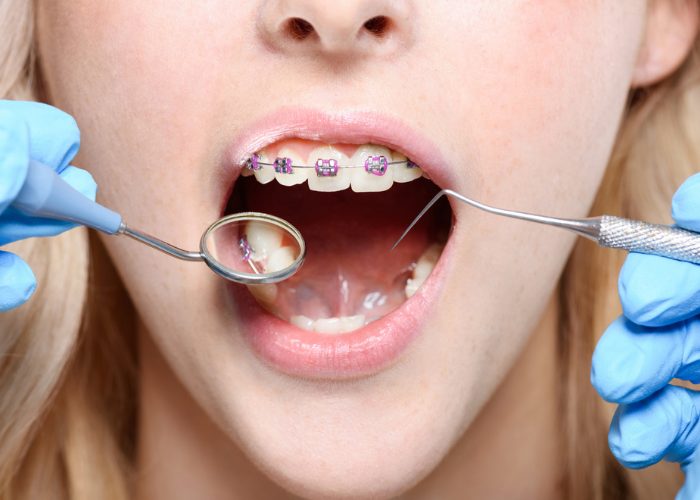
It’s time to talk about cost, but don’t run away too fast! It might be more reasonable than you think. There are many different options and usually some sort of payment plan can be worked out between you, your orthodontist, and your insurance company.
Braces don’t come cheap, but remember the benefits stay with you forever. It may mean stretching your finances a little, but it could be well worth it! Here’s an idea of how much adult braces cost according to Oral-B dental, who have been in the game since 1950:[19]
- Standard metal braces: $3,000 to $7,000
- Lingual braces: $8,000 $10,000
- Ceramic braces: $4,000 to $8,000
- Invisible braces: $4,000 to $7,400[20]
The above prices include the cost for the standard braces treatment, meaning both the braces materials, and follow up tightening appointments. Anything out of the ordinary, like needing a tooth removed to make space for the braces, may end up costing extra.
What Types of Braces Are There?
Today, there is a wide selection of different types of braces to fit your lifestyle needs. We’ve listed out the pros and cons of each type so you can decide on the best choice for you.
Ceramic Braces
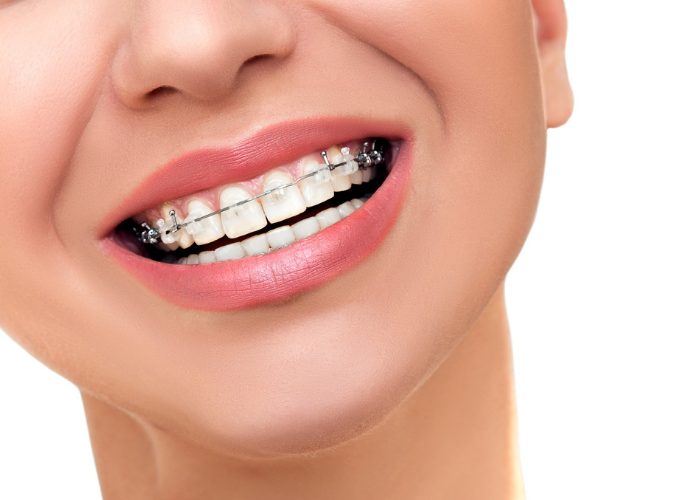
Ceramic braces are quite similar to metal braces. The difference lies in the coloring. Ceramic braces are clear/tooth-colored, so they blend in better to your normal smile.
Pro
- Less noticeable than metal braces because of their neutral coloring.
Con
- Because the ceramic is so strong, the metal wire might get abrasions where it connects to the bracket. That means the wire has more trouble shifting as the teeth move and has an increased risk of breaking or dislodging from the structure.[21]
- As ceramic is stronger than tooth enamel, these braces can cause the enamel to wear away under the brackets.[22]
- It’s not easy to clean ceramic braces. Food sticks to the brackets after meals, and flossing requires threading the floss between each wire and tooth. So, your brushing routine might need a few extra minutes.
Lingual Braces
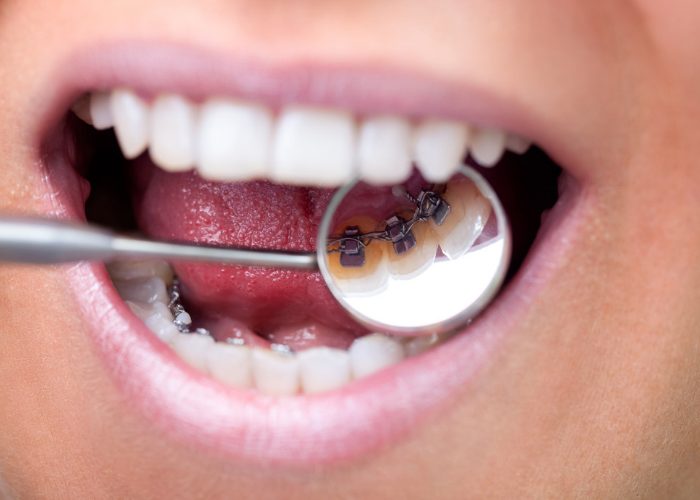
Lingual braces are placed on the interior side of the teeth, as opposed to the front of teeth where metal braces are usually set. These adult braces are perhaps the least noticeable in terms of visual aesthetics. However, some orthodontists are less likely to offer this option to patients because of the cons associated with them.[23]
Pro
- Because lingual braces are fixed onto the back of your teeth, they are less noticeable.
- They won’t cause any obvious staining on the tooth after removal.[24]
Con
- Lingual braces may cause irritation on the tongue.
- The internal brackets can cause speech trouble from crowding in the mouth.[25]
- They are more difficult for orthodontists to see/manage, and also more difficult for owners to clean.[26]
Metal Braces

This is the most common type of braces and probably what first comes into mind when you hear the word “braces”. Whilst they may not be the most aesthetically pleasing choice, they have advantages too. Metal braces are widely available, faster than invisible braces in total treatment time, and a lower-cost option.
Pro
- If you want to be bold and unapologetically you, these braces offer the chance to have colorful bands placed around each bracket. You can change the color to suit the season after every tightening appointment.
- Your orthodontist can attach elastic bands or springs to increase pressure or speed up movement.[27]
Con
- They’re the most noticeable.
- Like ceramic braces, metal braces are also not easy to clean. With bracket braces, it’s recommended to brush your teeth after every meal to avoid food staying stuck in all the nooks and crannies, which means you’ll probably spend more time brushing than normal.[28]
Invisible Braces
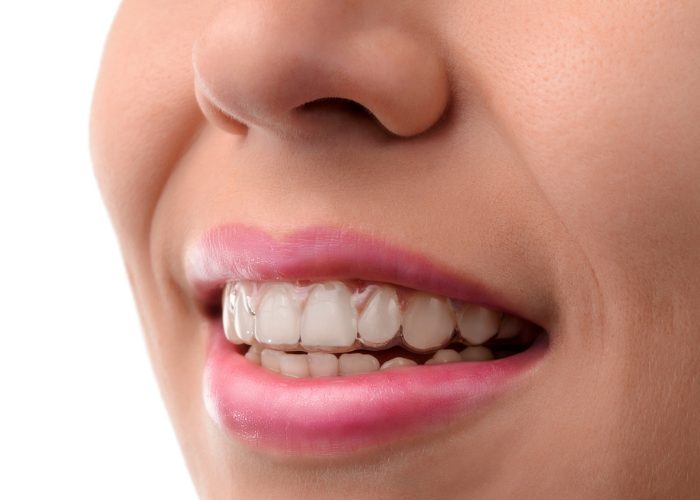
Maybe you want braces but your main concern is the “brace-face” culture and attitude towards them. Have no fear, clear braces are here! Invisible braces are very discrete, so you don’t have to feel self-conscious or worry about unleashing your laughter and smiles.
These are great as a type of adult braces because it’s one of the least noticeable versions, and they are easy to clean.
Pro
- They are removable so you can take them off when you eat or for special occasions. No need to worry about green spinach stuck between wires!
- They’re a breeze to clean. They won’t change your usual dental routine and you can floss and brush as usual.
Con
- Invisible or clear aligners are not ideal for those with severe tooth crowding or a deep bite because they mold to your tooth shape.[29] If that shape is too complex due to tooth crowding, the encasing will have a harder time achieving tooth movement.
- You have to have lots of self-discipline. There is a larger temptation to remove these braces when you don’t want to wear them. Non-compliance in patients makes these braces less effective in accomplishing the desired results on schedule.[30]
Invisalign vs. Braces
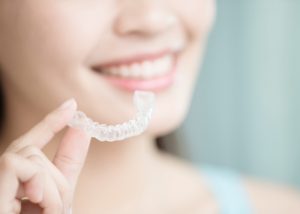
Invisalign is a brand of invisible braces that act like a retainer and are completely removable. Bracket braces are the more permanent treatment option that consists of metal or ceramic brackets glued to each tooth. These two types of treatment options have the same result (a straight smile!), but different means of getting there.
Check out the differences to help you decide which one is better for you.
- The brackets of standard metal or lingual braces can trap plaque.[31] This might sound a little gross, but don’t worry, you can easily clean off plaque build-up with your dentist or with regular brushing. Surprisingly, this plaque trap actually helps your gums stay healthy while your tooth moves around in them.[32]
- Invisalign braces are easier to clean. They are easily removable for meals and for your cleaning routine.
- One study showed that people who used Invisalign had better oral hygiene and generally better treatment experiences than those with bracket braces.[33]
- People with removable adult braces like Invisalign reported less pain than those with standard braces.[34]
- Standard metal braces can be cheaper than Invisalign in the best-case scenario. However, you can calculate the cost of your Invisalign braces and work something out with your insurance plan.
So both types of adult braces have their benefits, but it’s up to you which version you choose. And while potentially two years might seem like a long time to commit to something, rest easy knowing that by the end of it you’ll have a straight smile.
Fun Fact: Smiling more often is shown to positively increase people’s perceptions of a leader.[35]
How to Deal with Braces Pain

Regardless of the type of braces you choose, they will cause some discomfort as they alter the structure of your mouth. The first time your orthodontist puts them in place will probably feel the most shocking. You should also expect to experience some discomfort at your tightening appointments.
Here are some tips on how to deal with braces pain:
- The day before your appointment, prep some soft and liquid foods like mashed potatoes or homemade yogurt.
- If you are comfortable with it, take some painkillers right before you see your orthodontist.
- Use natural herbs to fight inflammation — peppermint is a great one. Throw some fresh peppermint in hot water or tea and sip away.
- Suck on ice cubes. But don’t bite them!
If you choose to get bracket braces, you may also experience mouth sores as the material rubs against your gums. Here are some tips on how to avoid mouth sores and manage their pain:
- Use wax! Your orthodontist should give you some wax to place over the brackets that are particularly annoying. This smooths over the area and can hopefully prevent any friction between the metal/ceramic braces and your gums.
- If you already have some sores, try rinsing your mouth with saltwater. This kills any germs in the sores and prevents them from getting infected and becoming more painful.[36]
- Try placing an oral patch over the sore. There are licorice root extract patches that have shown to help heal sores after just 30 minutes on the wound.[37]
Foods to Avoid with Bracket Braces
The brackets on standard braces are strong, but can still break or become damaged if you bite into a whole apple with vigor. So to keep pain at a minimum and the braces intact, there are a few foods to cross off your grocery list:
- Chewy taffy or caramel. This can harden around your braces, or pull the wire out of place with its sticky power.
- Raw, hard produce such as whole carrots or apples.
- Popcorn. The kernels can get stuck in the many new hiding spots in your mouth.
- Hard candy. Sucking on this should be fine. But in general, any food with a high sugar content is best to steer clear of. Sugar can discolor the teeth around the glued brackets, which can last a lifetime.[38]
Note: If you get removable braces, you can have your normal foods as per usual as there are no brackets to risk damaging.
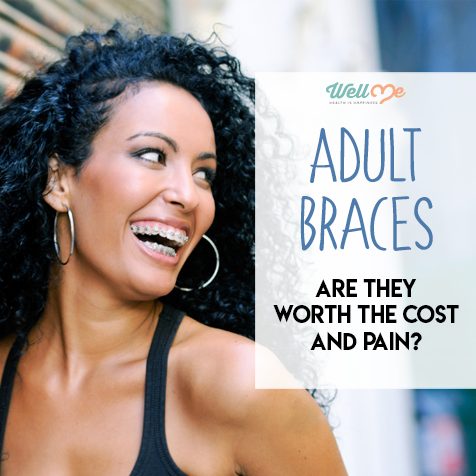
Conclusion
Whether you want to alleviate jaw pain from overcrowded teeth, or close the gap-tooth you’re feeling self-conscious about, there are adult braces to suit you.
And if you face a health or monetary restriction to getting braces, remember that you can find happiness in yourself just the way you are. The personal choice to get braces is something each person should make individually.
References
- [1] https://www.ncbi.nlm.nih.gov/pmc/articles/PMC1794626/
- [2] https://www.ncbi.nlm.nih.gov/pmc/articles/PMC5973581/
- [3] AJODO. https://www.ajodo.org/article/0889-5406(89)90455-1/pdf
- [4] https://academic.oup.com/ejo/article/30/4/386/392296
- [5] https://www.health.harvard.edu/oral-health/are-you-too-old-for-braces
- [6] NIH. https://clinicaltrials.gov/ct2/show/NCT02918240
- [7] https://www.ncbi.nlm.nih.gov/pubmed/26926017
- [8] http://sjod.org/eJournals/_eJournals/7_REVIEW%20ARTICLE.pdf
- [9] SJOD. http://sjod.org/eJournals/_eJournals/7_REVIEW%20ARTICLE.pdf
- [10] http://sjod.org/eJournals/_eJournals/7_REVIEW%20ARTICLE.pdf
- [11] https://www.ncbi.nlm.nih.gov/pubmed/29713922
- [12] NCBI. https://www.ncbi.nlm.nih.gov/pubmed/29713922
- [13] https://books.google.gr/books?hl=en&lr=&id=hO3OtjMZ3gcC&oi=fnd&pg=PR8&dq=four+teeth+layers&ots=_M585sCkZj&sig=J22v5EhHNGWDkBJ9C1YWD4NU2Hc&redir_esc=y#v=onepage&q=four%20teeth%20layers&f=false
- [14] https://books.google.gr/books?hl=en&lr=&id=hO3OtjMZ3gcC&oi=fnd&pg=PR8&dq=four+teeth+layers&ots=_M585sCkZj&sig=J22v5EhHNGWDkBJ9C1YWD4NU2Hc&redir_esc=y#v=onepage&q=four%20teeth%20layers&f=false
- [15] Cambridge Manuals in Archaeology. https://books.google.gr/books?hl=en&lr=&id=hO3OtjMZ3gcC&oi=fnd&pg=PR8&dq=four+teeth+layers&ots=_M585sCkZj&sig=J22v5EhHNGWDkBJ9C1YWD4NU2Hc&redir_esc=y#v=onepage&q=four%20teeth%20layers&f=false
- [16] https://www.health.harvard.edu/oral-health/are-you-too-old-for-braces
- [17] https://www.health.harvard.edu/oral-health/are-you-too-old-for-braces
- [18] Harvard Health. https://www.health.harvard.edu/oral-health/are-you-too-old-for-braces
- [19] https://oralb.com/en-us/oral-health/life-stages/braces/how-much-do-braces-cost
- [20] Oral B. https://oralb.com/en-us/oral-health/life-stages/braces/how-much-do-braces-cost
- [21] https://patents.google.com/patent/US20100330522A1/en
- [22] https://www.health.harvard.edu/oral-health/are-you-too-old-for-braces
- [23] NCBI. https://www.ncbi.nlm.nih.gov/pubmed/24005948
- [24] https://search.proquest.com/openview/ea36d41bf3d7eec3ea30bfabb3366860/1?pq-origsite=gscholar&cbl=41679
- [25] https://search.proquest.com/openview/ea36d41bf3d7eec3ea30bfabb3366860/1?pq-origsite=gscholar&cbl=41679
- [26] NCBI. https://www.ncbi.nlm.nih.gov/pubmed/24005948
- [27] https://www.health.harvard.edu/oral-health/are-you-too-old-for-braces
- [28] https://bmcoralhealth.biomedcentral.com/articles/10.1186/s12903-015-0060-4
- [29] New York State Dental Journal. https://search.proquest.com/openview/ea36d41bf3d7eec3ea30bfabb3366860/1?pq-origsite=gscholar&cbl=41679
- [30] https://search.proquest.com/openview/ea36d41bf3d7eec3ea30bfabb3366860/1?pq-origsite=gscholar&cbl=41679
- [31] https://search.proquest.com/openview/ea36d41bf3d7eec3ea30bfabb3366860/1?pq-origsite=gscholar&cbl=41679
- [32] New York State Dental Journal. https://search.proquest.com/openview/ea36d41bf3d7eec3ea30bfabb3366860/1?pq-origsite=gscholar&cbl=41679
- [33] https://www.ncbi.nlm.nih.gov/pubmed/26104387
- [34] https://www.sciencedirect.com/science/article/pii/S088954069870201X
- [35] University of Twente. https://essay.utwente.nl/72861/1/IBA%20Bachelor%20thesis%20Final%20Version%20Anna%20Goedecke.pdf
- [36] https://www.sciencedirect.com/science/article/pii/S0901502713011648
- [37] https://patents.google.com/patent/US7201930B2/en
- [38] Orthodontics Australia. https://orthodonticsaustralia.org.au/safe-foods-braces/


